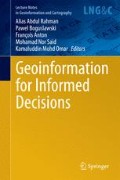Abstract
Ditches are important components of hydrological ecosystem and play a critical role in capturing and removing the micro-organisms and pollutants from water body. The generalization of ditches supports the multi-scale analysis and modeling of hydrological and ecological environment that relate to ditches. This paper proposes and implements a new method that combines two clustering ideas for typification of ditches. This method groups the ditches based on the edge-cutting of the minimal spanning tree of ditches, and represents the ditches in each group based on K-means++ algorithm. This study also presents the validation of the method with the experimental data of Guangzhou city.
Access this chapter
Tax calculation will be finalised at checkout
Purchases are for personal use only
References
Anders KH (2006) Grid typification. In: 12th international symposium on spatial data handling, progress in spatial data handling. Springer, Heidelberg, pp 633–642
Arthur D, Vassilvitskii S (2007) k-means++: the advantages of careful seeding. Proceedings of the 18th annual ACM-SIAM symposium on discrete algorithms 2007, pp 1027–1035
Bennett ER, Moore MT (2005) Vegetated agricultural drainage ditches for the mitigation of pyrethroid-associated runoff. Environ Toxicol Chem 24(9):2121–2127
Burghardt D, Cecconi A (2007) Mesh simplification for building typification. Int J Geogr Inf Sci 21(3–4):283–298
Dunn SM, Mackay R (1996) Modelling the hydrological impacts of open ditch drainage. J Hydrol 179(1–4):37–66
Foerster T, Stoter J (2008) Generalization operators for practice—a survey at national mapping agencies. In: Proceedings of the 11th ICA workshop on generalization and multiple representation, Montpellier
Li Z-l (2007) Digital map generalization at the age of enlightenment: a review of the first forty years. Cartograph J 44(1):80–93
McMaster R (1986) A statistical analysis of mathematical measures for linear simplification. Am Cartograph 13(2):103–116
Regnauld N (2001) Contextual building typification in automated map generalization. Algorithmica 30(2):312–333
Sandro S, Massimo R, Matteo Z (2011) Pattern recognition and typification of ditches. In: Ruas A(ed) Advances in cartography and giscience, Lecture Notes in Geoinformation and Cartography. Springer, Heidelberg, pp 425–437
Sergios T, Konstantinos K (2009) Pattern recognition, 4th edn. (ISBN 978-1-59749-272-0)
Sester M (2005) Optimization approaches for generalization and data abstraction. Int J Geogr Inf Sci 19(8–9):871–897
Shea KS, McMaster RB (1989) Cartographic generalization in a digital environment: when and how to generalize. In: Proceedings of Auto-carto 9, Baltimore, pp 56–67
Shindler M (2008) Approximation algorithm for the metric k-median problem. Masters thesis, Department of Computer Science, UCLA
Smith DR (2009) Assessment of in-stream phosphorus dynamics in agricultural drainage ditches. Sci Total Environ 407(12):3883–3889
Topfer F, Pillewizer W (1966) The principles of selection: a means of cartographic generalization. Cartograph J 3(1):10–16
Zahn CT (1971) Graph-theoretical methods for detecting and describing gestalt clusters. IEEE Trans Comput 20(1):68–86
Zhang Q-n (2007) Drainage typification based on dendritic decomposition. Cartograph J 44(4):321–328
Zhang X, Ai T-h, Stoter J, Kraak MJ, Molenaar M (2013) Building pattern recognition in topographic data: example on collinear and curvilinear alignments. Geoinformatica 17(1):1–33
Acknowledgments
We would especially like to thank the two anonymous reviewers for their helpful comments. Work describe in this article was supported by project from the National Science Foundation for Fostering Talents in Basic Research of the National Natural Science Foundation of China (Grant No. J1103409).
Author information
Authors and Affiliations
Corresponding author
Editor information
Editors and Affiliations
Rights and permissions
Copyright information
© 2014 Springer International Publishing Switzerland
About this chapter
Cite this chapter
Tian, J., Yang, W.Y., Chen, L.J. (2014). Combining Two Clustering Ideas for Typification of Ditches. In: Abdul Rahman, A., Boguslawski, P., Anton, F., Said, M., Omar, K. (eds) Geoinformation for Informed Decisions. Lecture Notes in Geoinformation and Cartography. Springer, Cham. https://doi.org/10.1007/978-3-319-03644-1_13
Download citation
DOI: https://doi.org/10.1007/978-3-319-03644-1_13
Published:
Publisher Name: Springer, Cham
Print ISBN: 978-3-319-03643-4
Online ISBN: 978-3-319-03644-1
eBook Packages: Earth and Environmental ScienceEarth and Environmental Science (R0)

